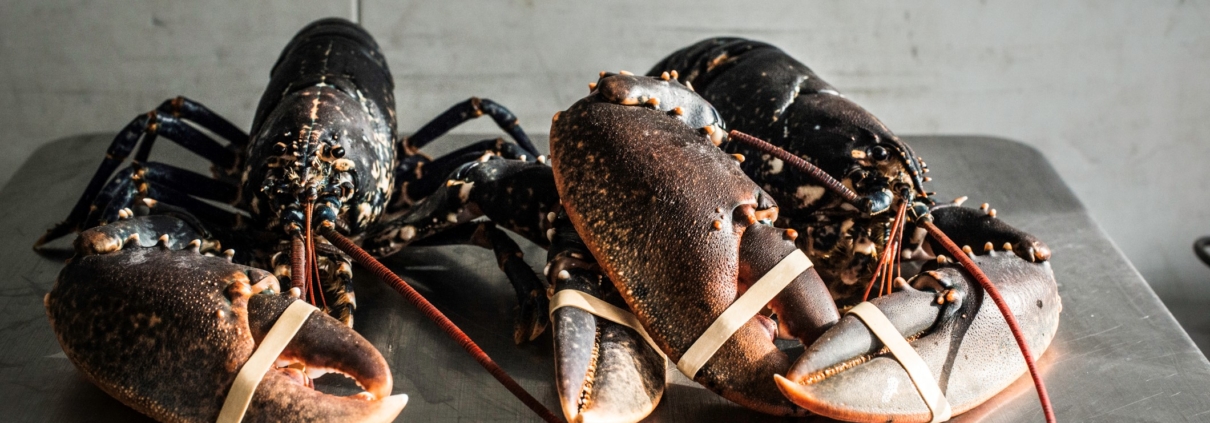How to buy a Scottish Lobster (Homarus gammarus)
Introduction
The earliest records of Lobster fishing can be dated back to 12th Century, when they were caught using crook nets. It is more common today to catch Lobsters using bated creels. The majority of landings come from the East Coast, Hebrides, Orkney and South Minch.
What they feed on?
European Lobsters tend to live on hard ground in shallow waters on the edge of Kelt beds. Their diets consist of benthic invertebrates (crabs, sea urchins, star fish etc.) and also plants and fish.
How long do they live?
Lobsters can grow very old, the oldest recorded lobster being 72 years old. The potential reproductive lifespan of a female is 40 years old.
A year in the life of a lobster
June and July
Eight Five per cent of all lobster shed their shells (moult) during June and July. After moulting the new shell is very soft. The result of this is that the weight of a lobster is made up of more water than meat, up to 90% after first moulting. A soft shelled Lobster is therefore very expensive, as you are paying for a lot of sea water!
Lobsters mate just after shedding their sell, which is another reason for not buying soft shelled lobster (or any crustaceans).
July to September
Feeding time!!
During this time the Lobsters build up the strength of their shell and are in a feeding frenzy, the meat content rises to a peak, so they are ready to face the hard winter, when they hibernate. The end of summer/beginning of autumn is therefore the best time to have lobster on your menu.
The meat content is so much higher at the end of the summer that even if the price per kg of a whole lobster was three times that of when it first moulted, it would still be cheaper per kg of lobster meat.
September and October
The lobster starts to slow down its feeding and get ready to hibernate for winter. This is still a good time to have lobster on your menu, because they are both high in meat and also still being caught in good numbers by the fishermen, so the price tends to be good.
November – February (Hybernation)
Over the winter months when the water temperature drops lobsters go into hibernation to conserve energy. They hibernate in deep water, which makes them harder to catch.
March – May
As water temperatures start to heat up, lobsters return to more shallow ground, after few months in hibernation they are hungry and they go on another feeding frenzy, making spring another good time to put lobster on the menu.
Making lobster fishing more sustainable
Fishermen in some of the most remote and wild corners of Scotland, would not be able to survive and provide for their families if they only could fish for lobster in late summer, early Autumn and spring. Therefore modern techniques/technology have been adopted to extend the seasons and also make fishing more sustainable.
Rather than putting soft shelled lobster back into the water to grow, they now put them into tanks and transport them to sea cages on shallow beds, where they mate. The males are kept in the cages and sold as food over the winter months, which allows the fishermen a continued income over the tougher winter months. The females who carry their fertilized eggs for 9-11 months before hatching are returned to the wild. The “berried” females are very difficult to catch during this time, nature!
During the moulting months these fishermen also grade out the harder shelled fish that don’t moult (15%) and also those that have not moulted yet, allowing them to sell these ones during the summer months.
What to look out for when buying a lobster
The majority of fishermen are honest and trustworthy, like anything there are also a few out to make a quick buck, who would happily sell a soft shelled lobster. The most important things to watch when buying a lobster are, in this order.
Is the lobster carrying eggs?
How hard is its shell?
Only after working out these two things should you look at price per kg
Interested in buying Scottish Lobster
Contact Jeremy@ochilfoods.co.uk
All our lobsters come from Arbroath and Orkney.



Can you tell me about more about a Scottish lobster as one was caught tonight at sea it’s 2 feet long and about 2 killos , blue and brown in colour thanks 😊